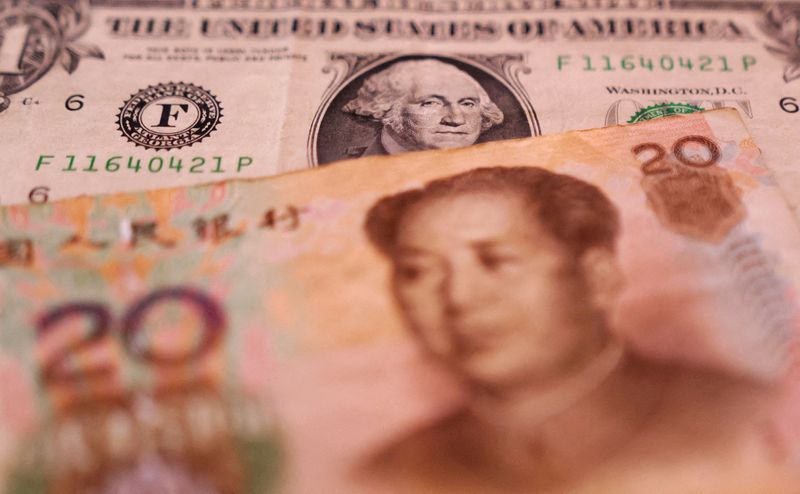
By Jamie McGeever
ORLANDO, Florida (Reuters) -It’s safe to say that the timing and scale of the stimulus measures unleashed by China this week were, in large part, prompted by the U.S. Federal Reserve’s jumbo-sized interest rate cut only a few days before.
But unfortunately for Chinese policymakers, the U.S. central bank’s apparent commitment to an aggressive easing campaign – and the impact this could have on the exchange rate between the yuan and the dollar – could put Beijing in a serious bind.
On the face of it, the yuan’s substantial appreciation against the dollar in the two months to Monday was baffling. While an increasingly gloomy domestic economic outlook slammed Chinese stocks and bond yields lower, the yuan powered to a 16-month high.
And then the yuan got another boost this week, as Beijing rolled out a series of liquidity, monetary and fiscal stimulus measures running into the trillions of yuan. The offshore yuan has scaled the 7.00 per dollar barrier for the first time since January 2023.
This latest whoosh makes more sense. Investors are betting that Beijing is finally taking the serious measures required to revive growth. It’s notable that the yuan’s rally this week has been accompanied by surging stocks and higher bond yields.
In the long run, a strong currency is good news for China. It will boost foreign investor sentiment and attract capital inflows while raising China’s nominal dollar-denominated GDP – a metric Beijing will need to be keenly focused on if it ever wants to truly rival or even surpass the U.S.
On that note, China’s nominal annual GDP growth rate right now is lower than that of Japan and the U.S., something few would have predicted only a few years ago.
But the short-term picture is more complicated. With growth cratering and deflationary forces intensifying, the last thing China’s economy needs is a strong exchange rate. Policymakers will welcome the renewed optimism around China, but not the strong currency that generates.
Stephen Jen, co-founder of hedge fund Eurizon SLJ and long-time China watcher, thinks Beijing is stuck between a rock and a hard place. As the Fed’s easing cycle rolls on, the dollar’s floor against the yuan will almost certainly drop.
“I continue to believe USD/CNY is heading lower, possibly by 10% in the coming year. Almost everyone is the wrong way around. Positioning adjustment will make this prospective decline non-linear,” he wrote on Wednesday.
LIMITED OPTIONS
The People’s Bank of China is obviously powerless to stop the Fed from slashing U.S. rates. So if the PBOC wants to prevent an overvaluation of the yuan, it could either lower China’s various lending rates or initiate a bond-buying, or ‘quantitative easing,’ program.
But it has limited scope to do the former, and even less desire to do the latter. That being the case, it could use one other tool to keep the exchange rate from overheating: buying dollars.
This plan involves high political risk, though. China and the United States are in a trade war that has escalated meaningfully in recent years. This has deepened the political divide between the two superpowers, which is partly why China has reduced its holdings of U.S. Treasuries.
China’s official stash of U.S. Treasuries has fallen 30% from a post-pandemic peak of $1.1 trillion in early 2021. Its overall holdings of dollar-denominated assets have not shrunk anywhere near as much, but the direction of travel is clear. Ramping up purchases of America’s currency and government debt would likely be a difficult sell for Beijing domestically.
What’s more, the incoming U.S. presidential administration, whether it be headed by Kamala Harris or Donald Trump, would almost certainly baulk at what it would surely allege to be currency manipulation. Retaliatory action, perhaps in the form of even more punitive tariffs, would likely follow.
In other words, Beijing can no longer consider bursts of FX intervention a reliable default strategy.

So even though the steps taken this week may have gotten China back on the path to a long-term recovery, its currency conundrum could ensure the road is rocky in the short term.
(The opinions expressed here are those of the author, a columnist for Reuters.)
(By Jamie McGeever; Editing by Andrea Ricci)
This post is originally published on INVESTING.




